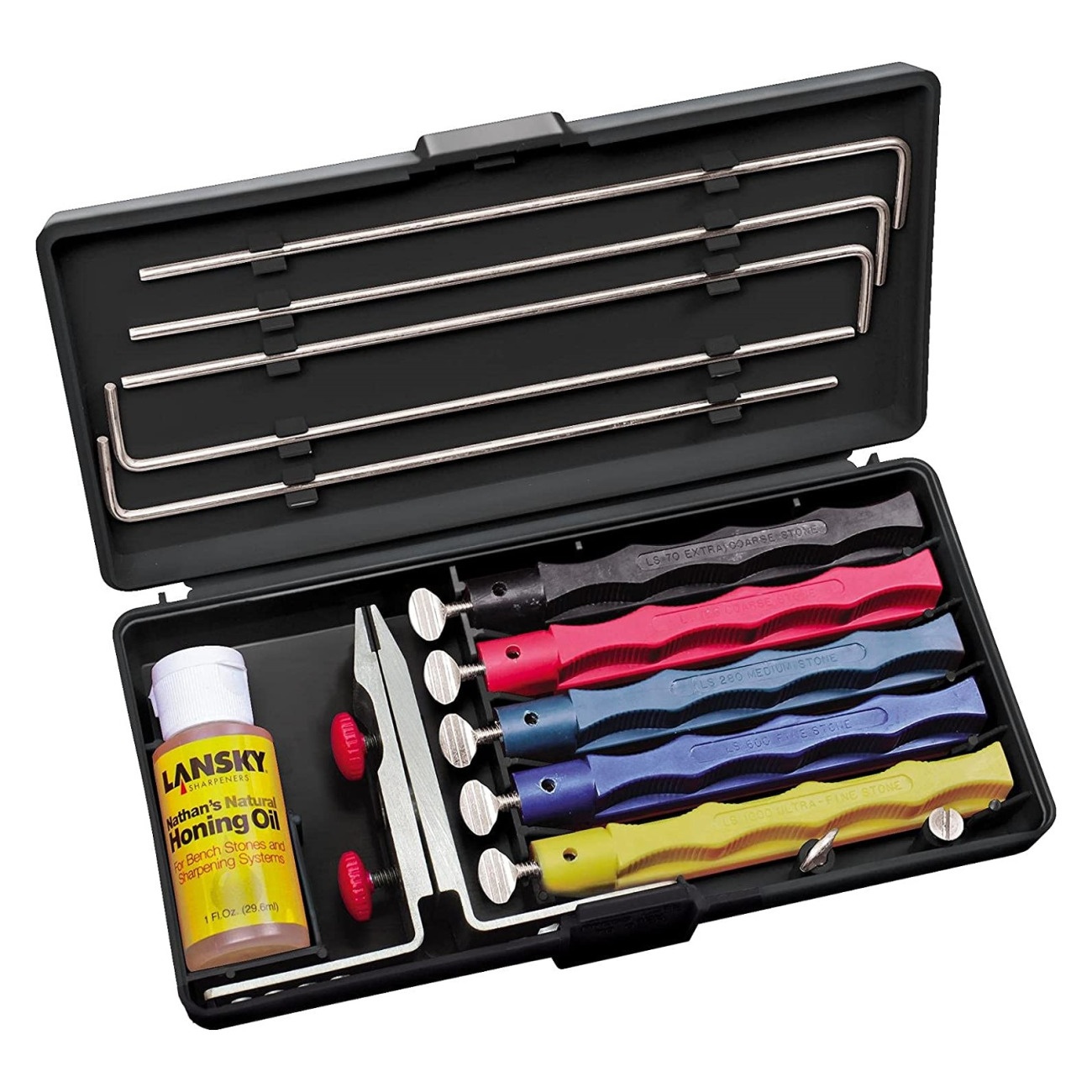Lansky Deluxe 5-Stone Knife Sharpener
Highlights
Product attributes
Oil bottle
Box
Nubbed locking screw
Honing stone (excluding guide rod locking screw)
Guide rod locking screw
Guide rod
Front screw (star)
Clamp
Galleries
In the box
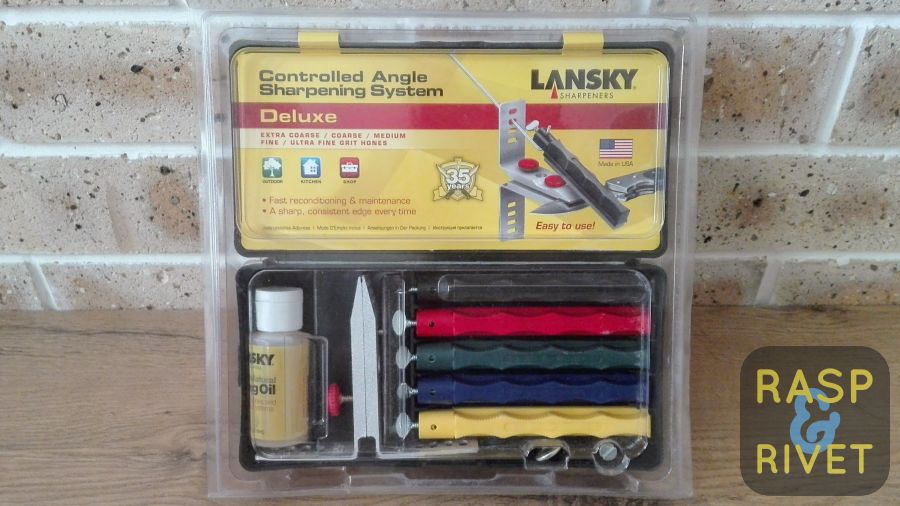 the front of the lansky deluxe package
the front of the lansky deluxe package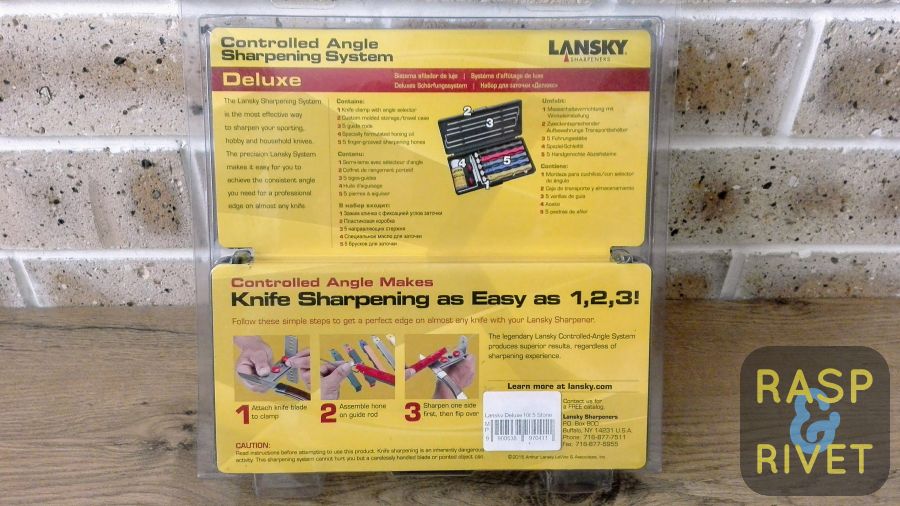 the back of the lansky deluxe package
the back of the lansky deluxe package the lansky box with all components inside, alongside the lansky manual
the lansky box with all components inside, alongside the lansky manual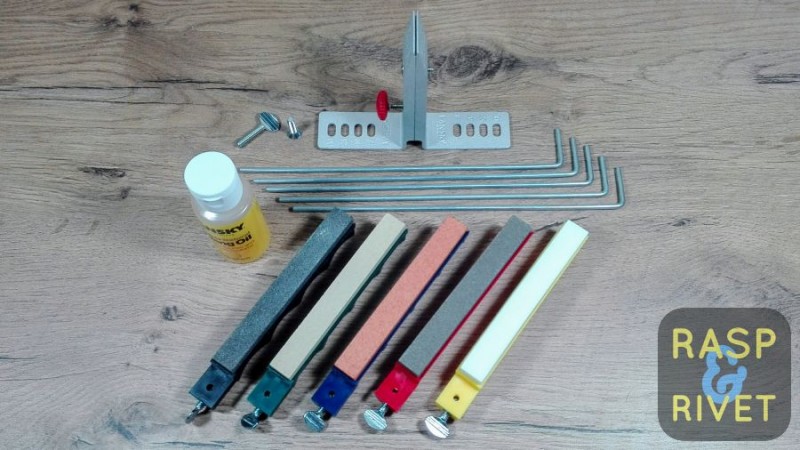 all of the components of the lansky deluxe set, posing for a group photo
all of the components of the lansky deluxe set, posing for a group photo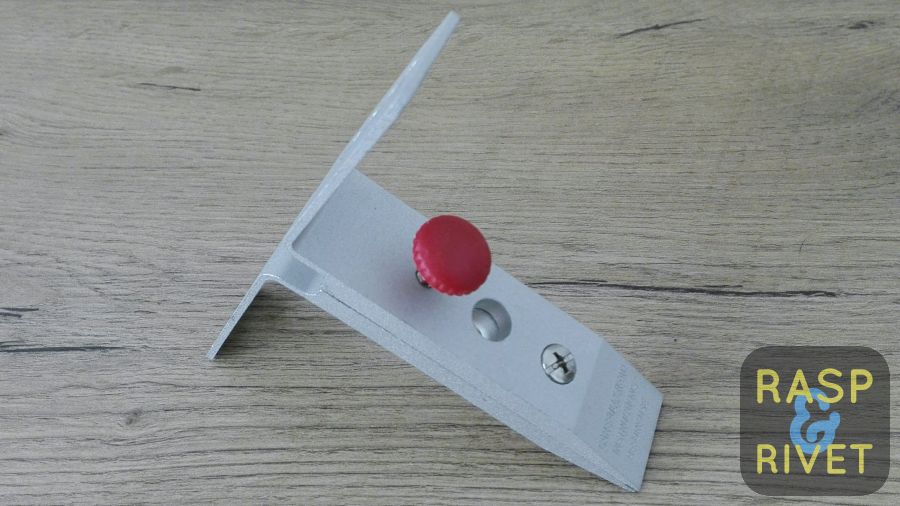 the lansky knife clamp
the lansky knife clamp the blade groove at the front of the knife clamp
the blade groove at the front of the knife clamp the slots and angle indicators at the back of the lansky knife clamp
the slots and angle indicators at the back of the lansky knife clamp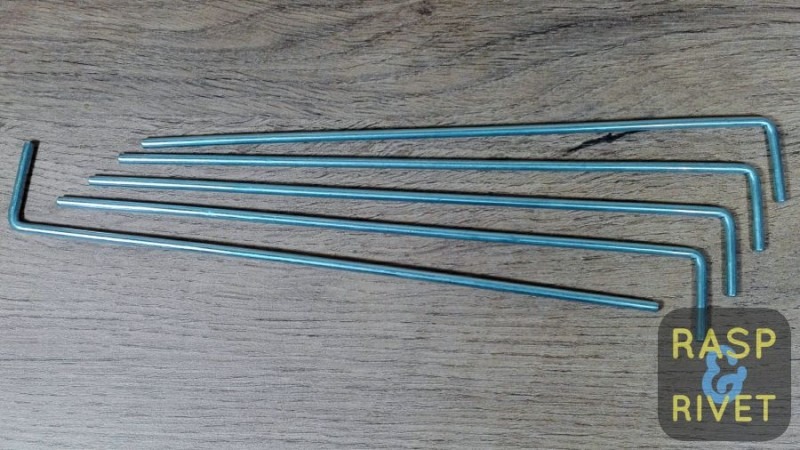 five guide rods
five guide rods natural honing oil
natural honing oil the black handled 70 grit lansky sharpening stone
the black handled 70 grit lansky sharpening stone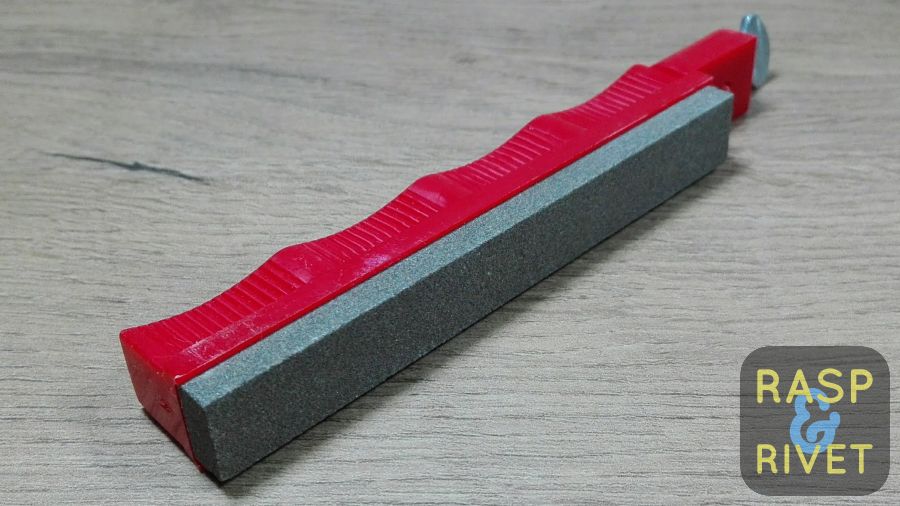 the red handled 120 grit lansky sharpening stone
the red handled 120 grit lansky sharpening stone the green handled 280 grit lansky sharpening stone
the green handled 280 grit lansky sharpening stone the yellow handled 1000 grit lansky sharpening stone
the yellow handled 1000 grit lansky sharpening stone extra honing stone wingnut
extra honing stone wingnut extra front screw for clamp
extra front screw for clampDislikes
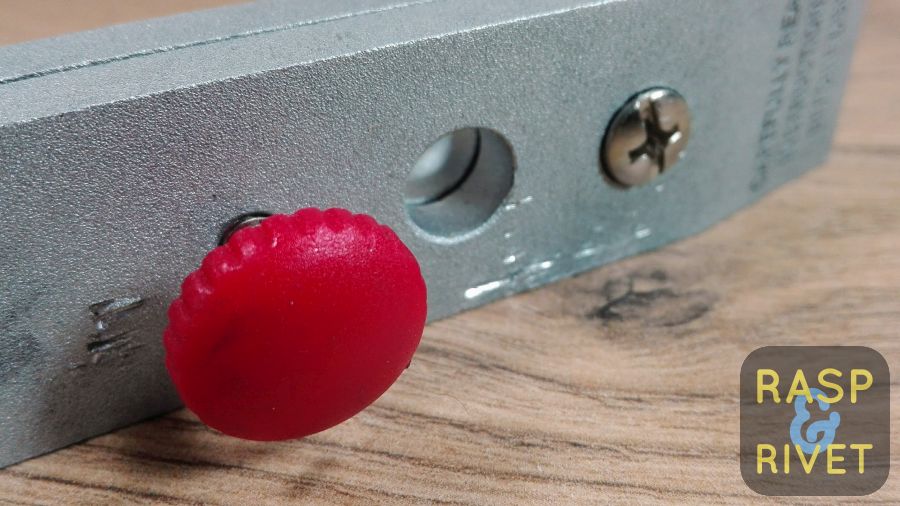 tighten the red headed screw with a pair of pliers to prevent a blade from moving while clamped in the lansky
tighten the red headed screw with a pair of pliers to prevent a blade from moving while clamped in the lanskyPrice
 i sharpened 16 edges with the lansky, with a combined length of 1784mm
i sharpened 16 edges with the lansky, with a combined length of 1784mmHow to use
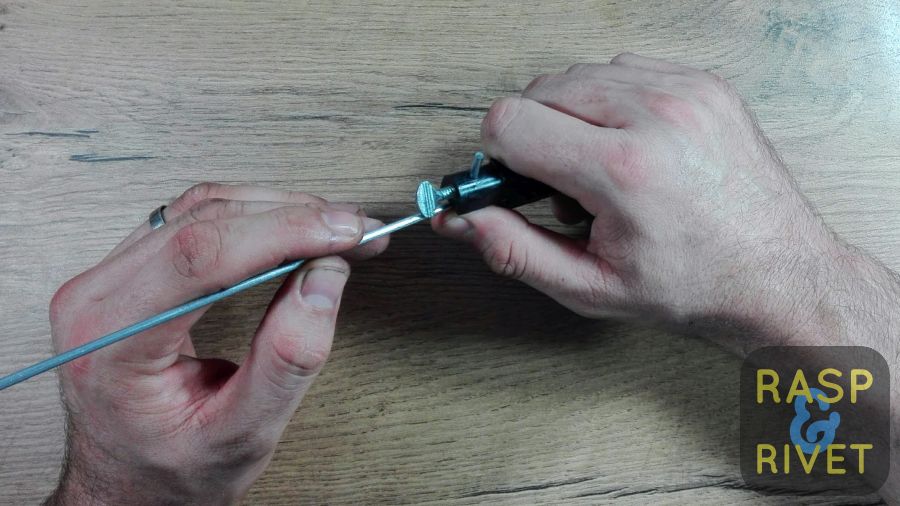 attach the guide rod to the honing stone
attach the guide rod to the honing stone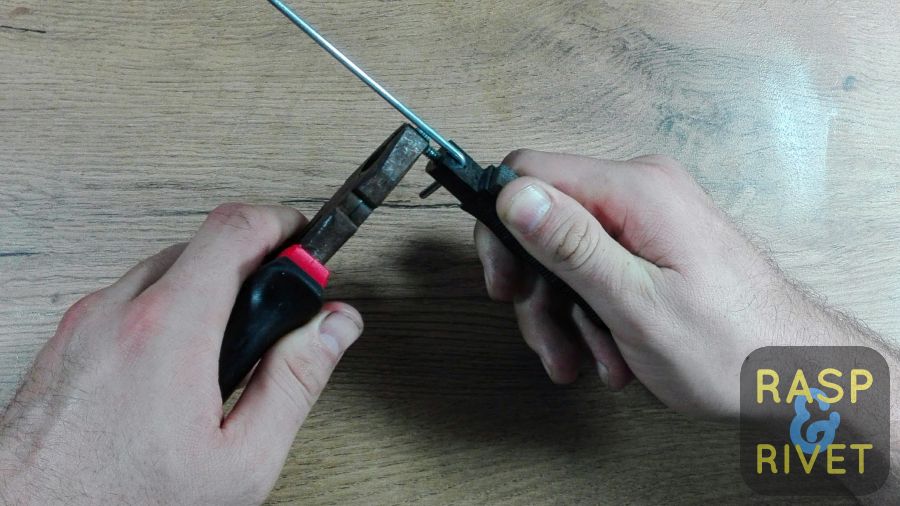 tighten the guide rod using pliers
tighten the guide rod using pliers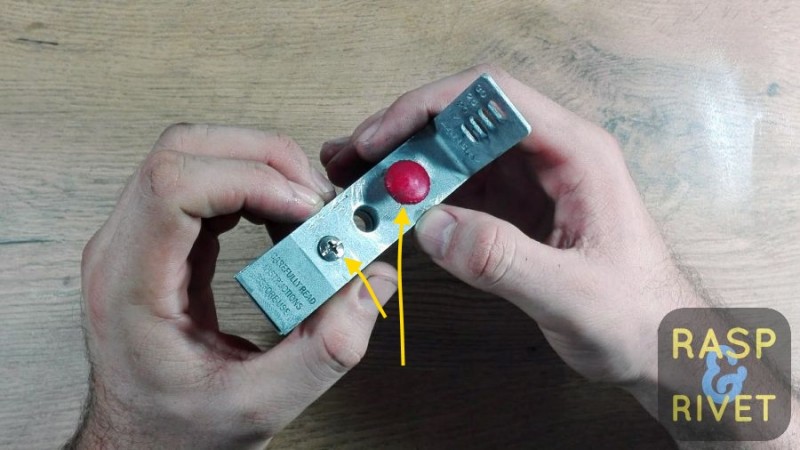 make sure the knife clamp bolts are loose
make sure the knife clamp bolts are loose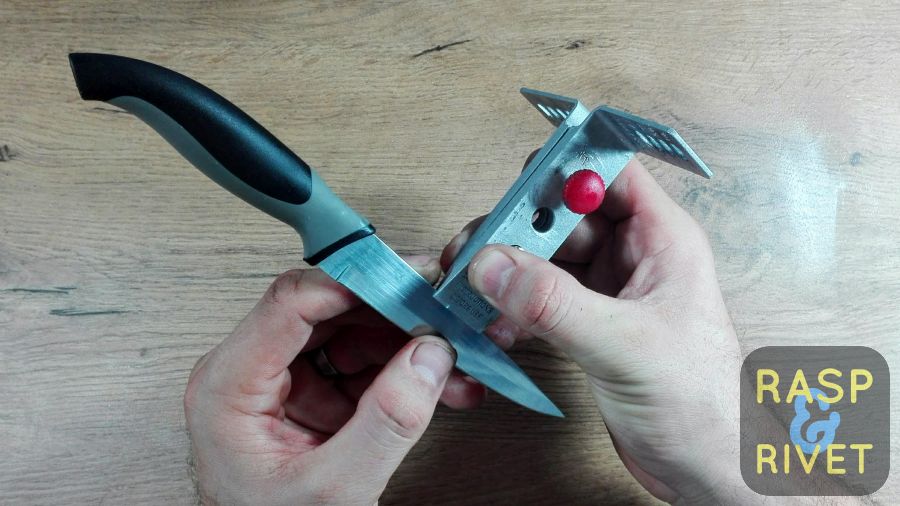 slide the knife in the knife clamp slot
slide the knife in the knife clamp slot if the blade's wide, don't worry about using the slot. seat the knife against the phillips screw
if the blade's wide, don't worry about using the slot. seat the knife against the phillips screw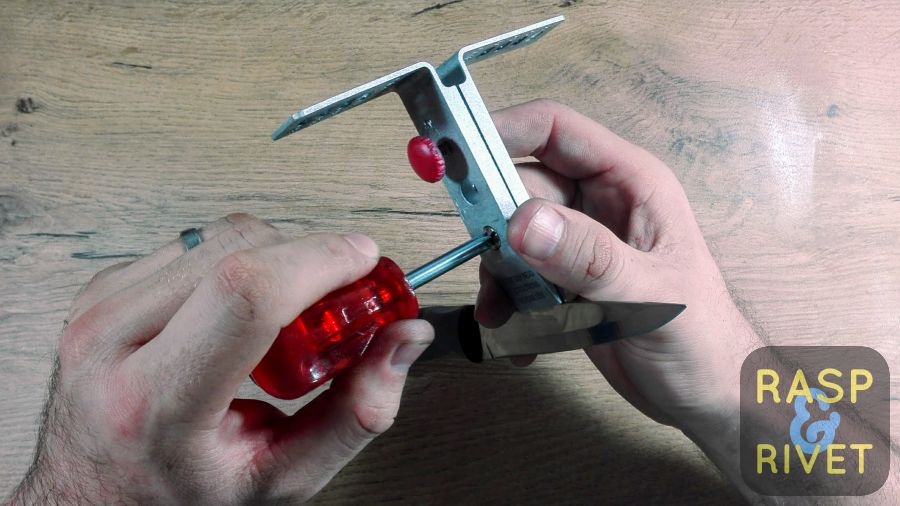 tighten the phillips screw
tighten the phillips screw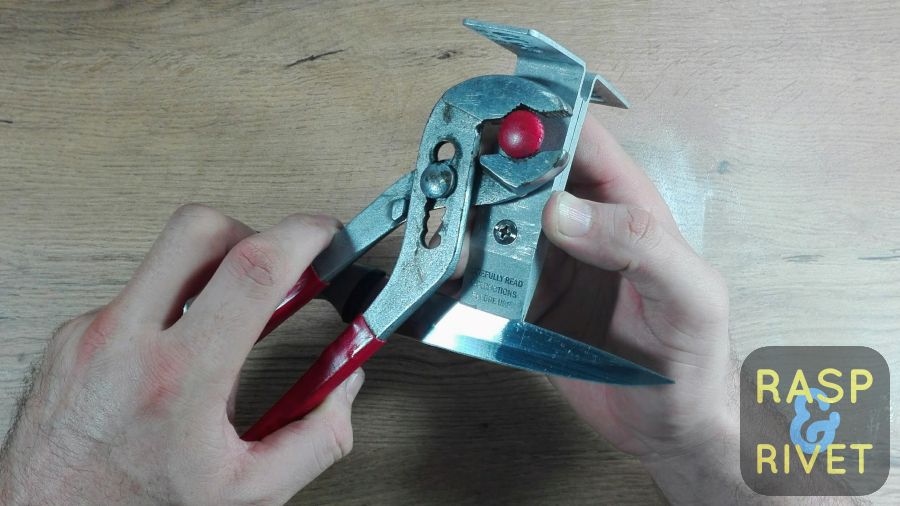 tighten the knurl knob screw with a pair of pliers
tighten the knurl knob screw with a pair of pliers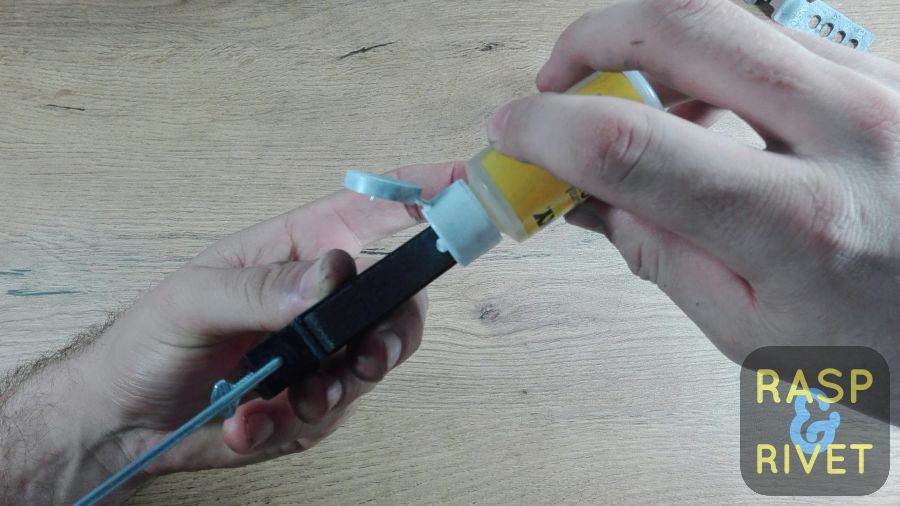 add a few drops of oil to the honing stone
add a few drops of oil to the honing stone a few drops of oil on the 70 grit honing stone
a few drops of oil on the 70 grit honing stone spread the oil across the honing stone's surface
spread the oil across the honing stone's surface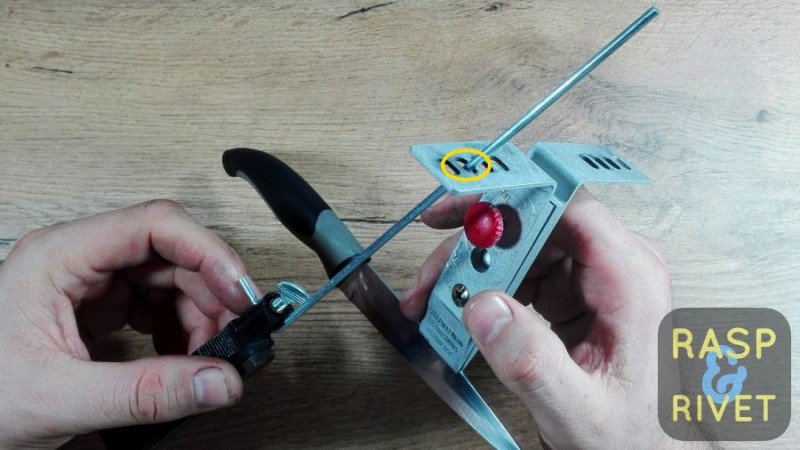 slide the guide rod into one of the angle slots on the lansky clamp
slide the guide rod into one of the angle slots on the lansky clamp lay the honing stone on the blade's edge
lay the honing stone on the blade's edge applying pressure, push the stone up and sideways, towards the centre of the clamp. cover one to two inches
applying pressure, push the stone up and sideways, towards the centre of the clamp. cover one to two inches flip the whole thing over. on the other side, slide the guide rod into one of the angle slots on the lansky clamp
flip the whole thing over. on the other side, slide the guide rod into one of the angle slots on the lansky clamp lay the honing stone on the blade's edge
lay the honing stone on the blade's edge applying pressure, push the stone up and sideways, towards the centre of the clamp. cover one to two inches
applying pressure, push the stone up and sideways, towards the centre of the clamp. cover one to two inchesSharpening angles
 the true sharpening angle is determined by the width of the blade you're sharpening
the true sharpening angle is determined by the width of the blade you're sharpening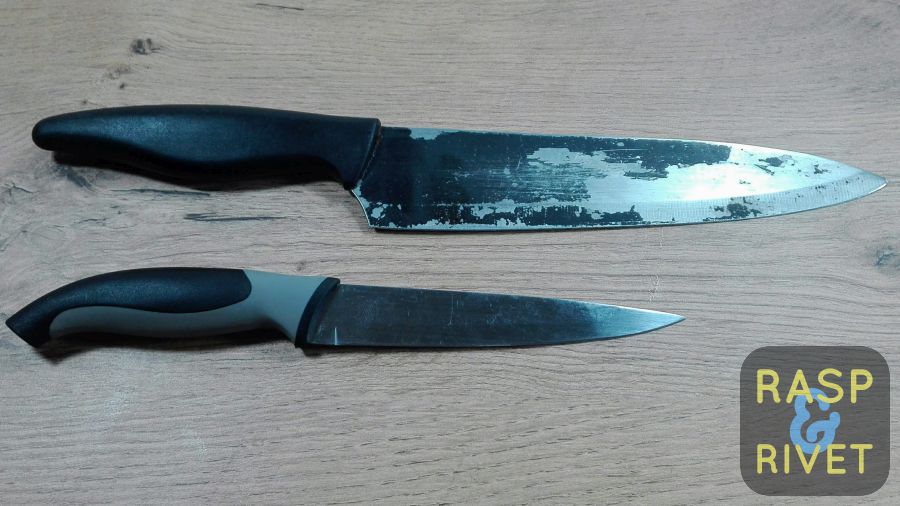 the chef's knife and steak knife i used for measuring the lansky's true sharpening angles
the chef's knife and steak knife i used for measuring the lansky's true sharpening angles blade cutting edge lengths
blade cutting edge lengths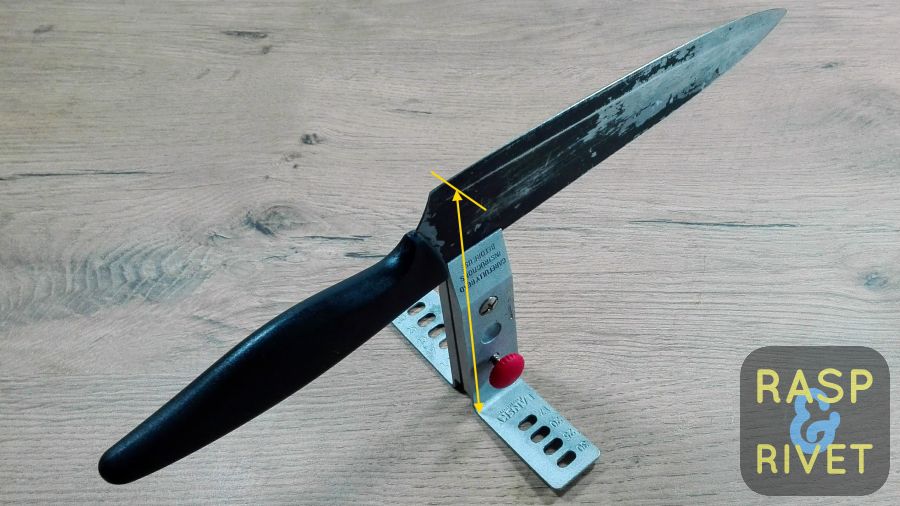 chef's knife shortest right angle length
chef's knife shortest right angle length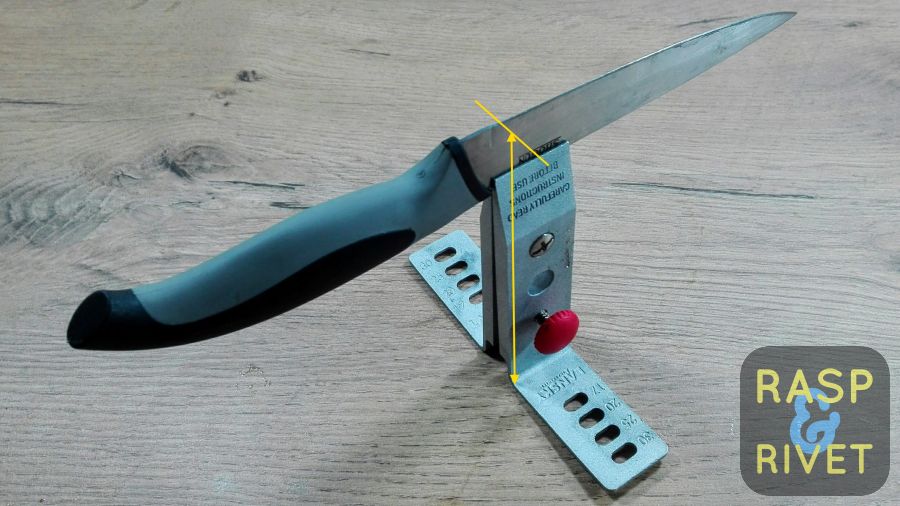 steak knife shortest right angle length
steak knife shortest right angle length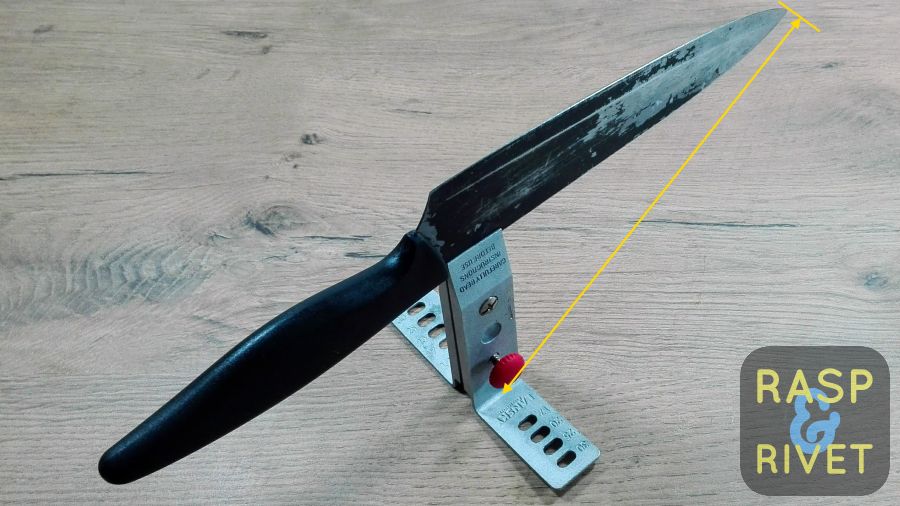 chef's knife longest right angle length
chef's knife longest right angle length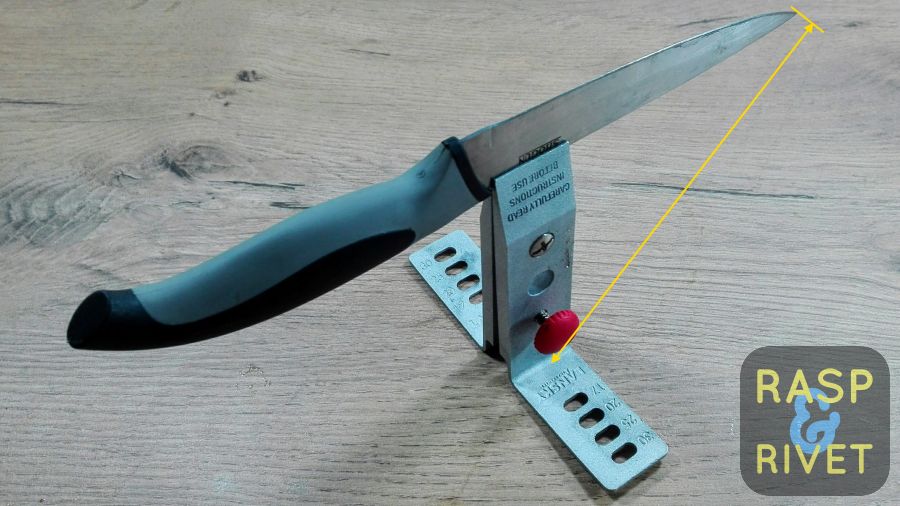 steak knife longest right angle length
steak knife longest right angle length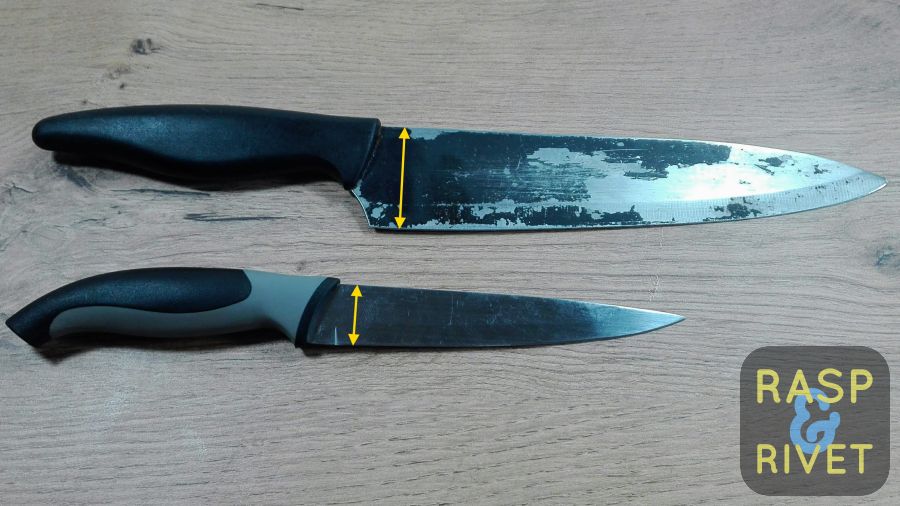 blade widths at widest points
blade widths at widest pointsSharpening
 the steak knife after sharpening
the steak knife after sharpening the steak knife before sharpening
the steak knife before sharpening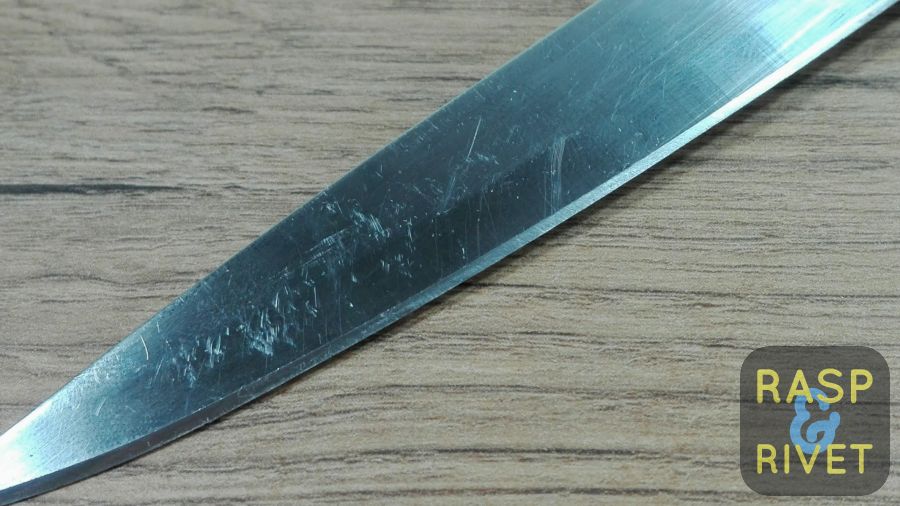 the steak knife after sharpening
the steak knife after sharpening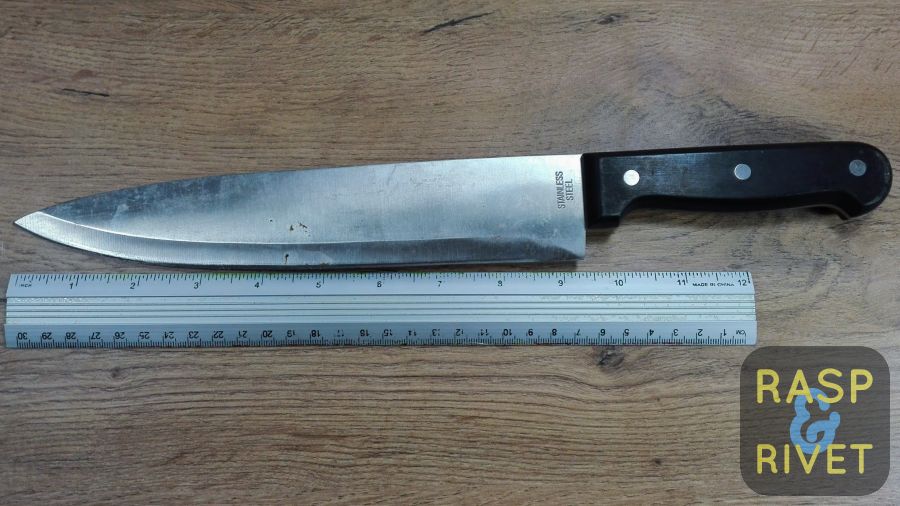 i found this huge chef's knife in a drawer in the kitchen
i found this huge chef's knife in a drawer in the kitchen it's a monster of a knife, but the blade was dull
it's a monster of a knife, but the blade was dull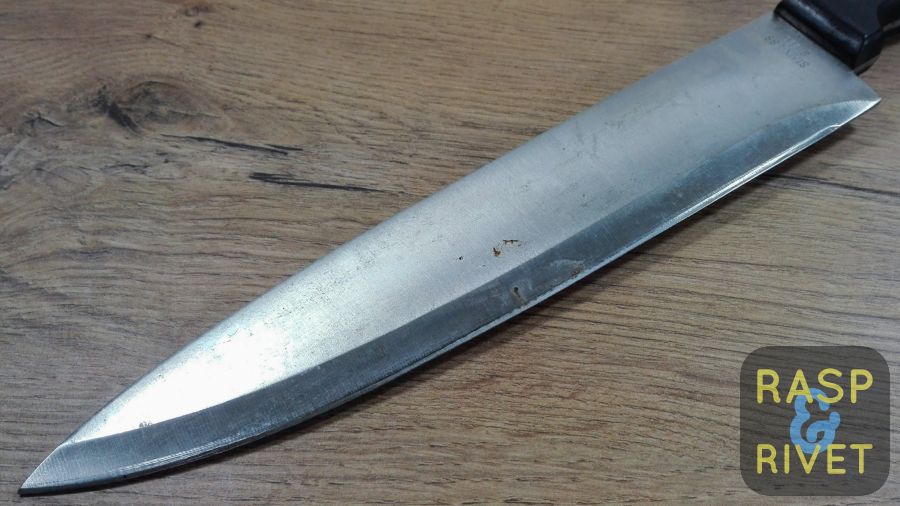 one side of the chef's knife before sharpening
one side of the chef's knife before sharpening the other side of the chef's knife before sharpening
the other side of the chef's knife before sharpening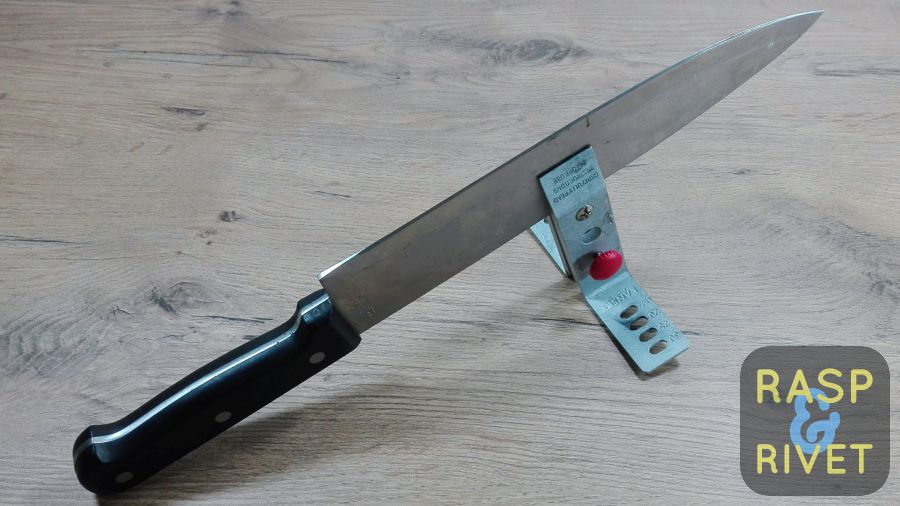 the chef's knife clamped in the lansky, ready to be sharpened
the chef's knife clamped in the lansky, ready to be sharpened one side of the chef's knife after sharpening
one side of the chef's knife after sharpening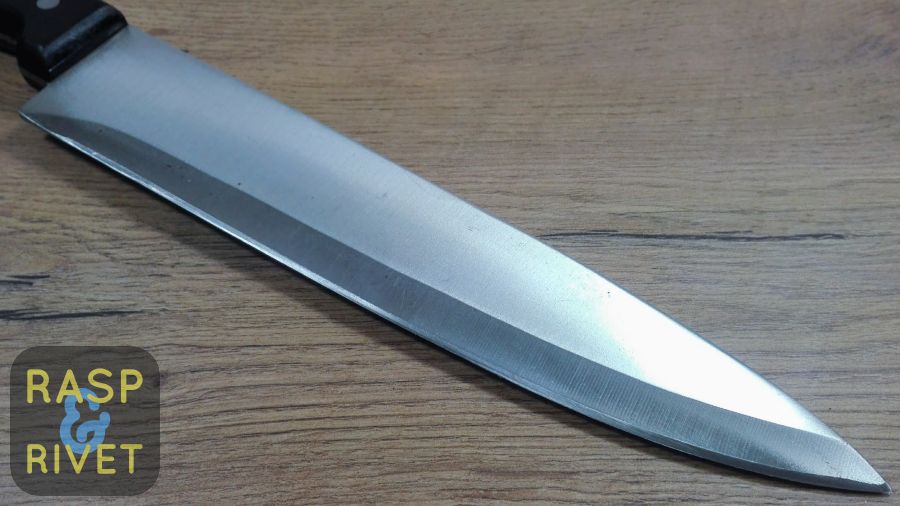 the other side of the chef's knife after sharpening
the other side of the chef's knife after sharpening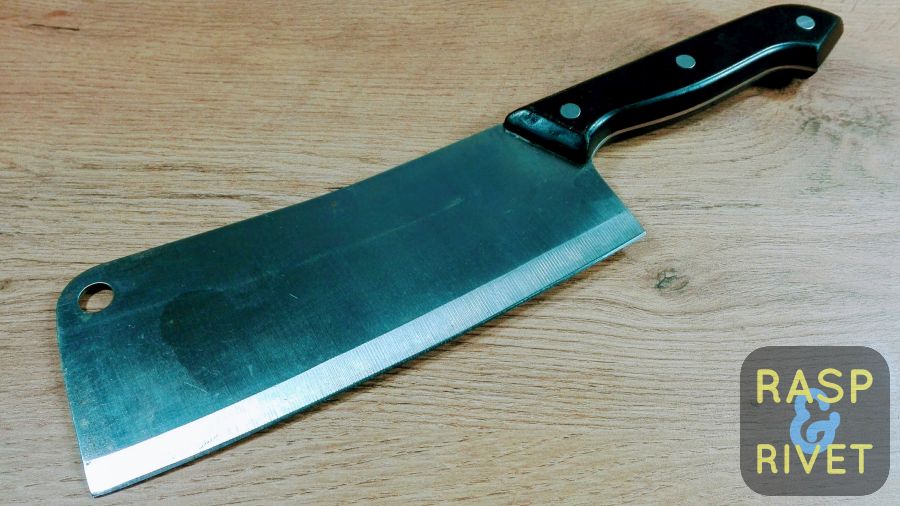 a meat cleaver i found in my wife's kitchen
a meat cleaver i found in my wife's kitchen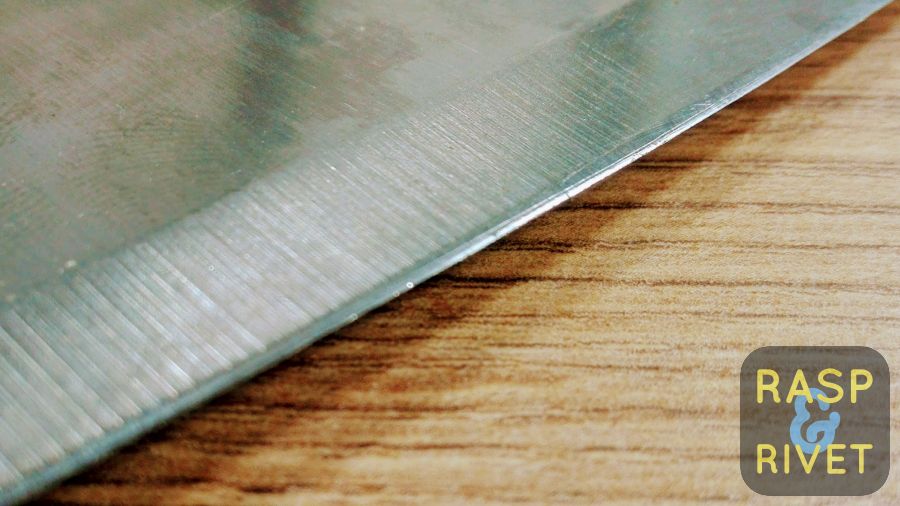 one of the meat cleaver's edges before sharpening with the lansky
one of the meat cleaver's edges before sharpening with the lansky the meat cleaver's other edge after sharpening with the lansky
the meat cleaver's other edge after sharpening with the lansky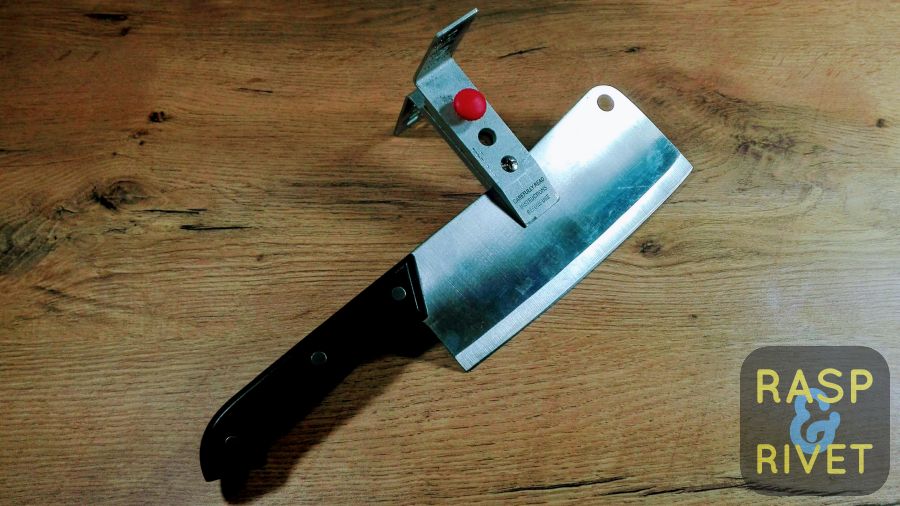 the meat cleaver clamped inside the lansky
the meat cleaver clamped inside the lansky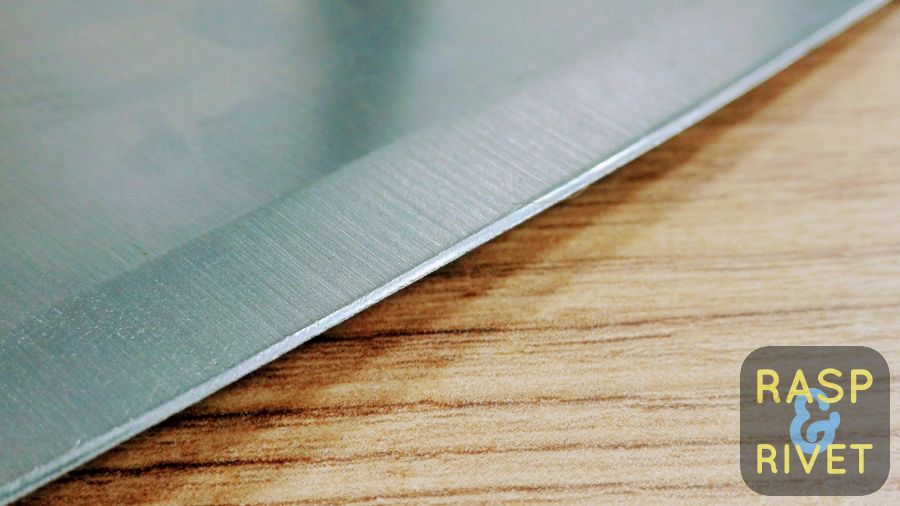 one of the meat cleaver's edges after sharpening with the lansky
one of the meat cleaver's edges after sharpening with the lansky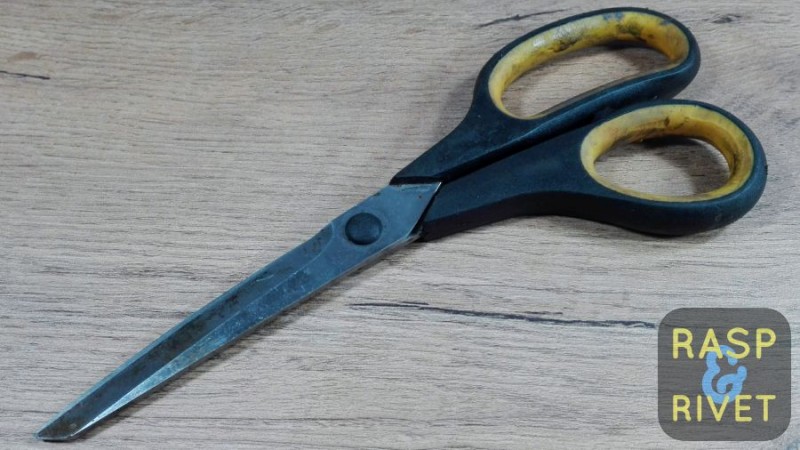 an old pair of scissors i sharpened with the lansky
an old pair of scissors i sharpened with the lansky i disassembled the pair of scissors with a screwdriver
i disassembled the pair of scissors with a screwdriver one half of the pair of scissors secured to the lansky with a vice grip
one half of the pair of scissors secured to the lansky with a vice grip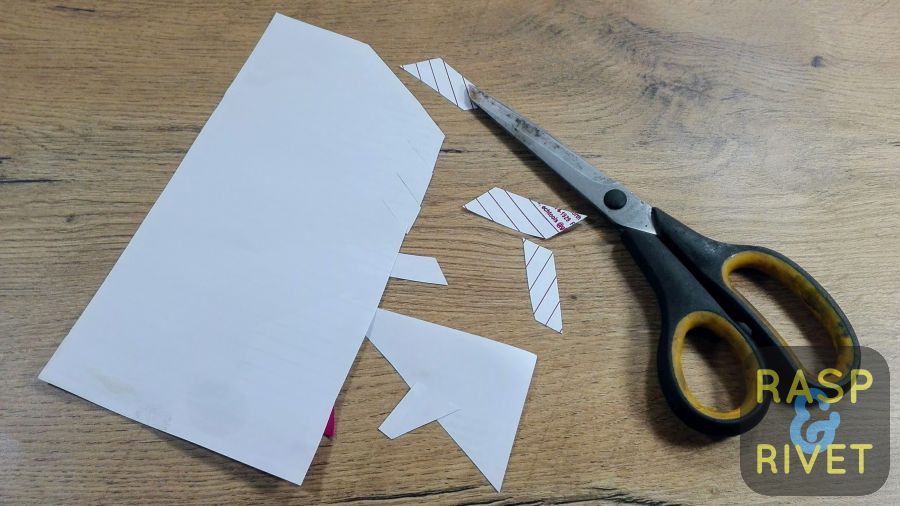 cutting some paper after sharpening the scissors with the lansky
cutting some paper after sharpening the scissors with the lansky i sharpened this axe with the lansky 5 stone deluxe
i sharpened this axe with the lansky 5 stone deluxe a vice grip securing the two parts of the knife clamp to the axe
a vice grip securing the two parts of the knife clamp to the axe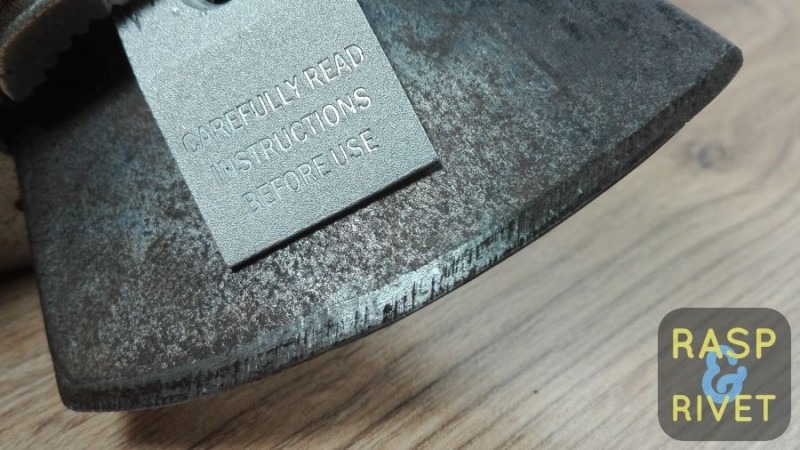 one side of the axe head before sharpening
one side of the axe head before sharpening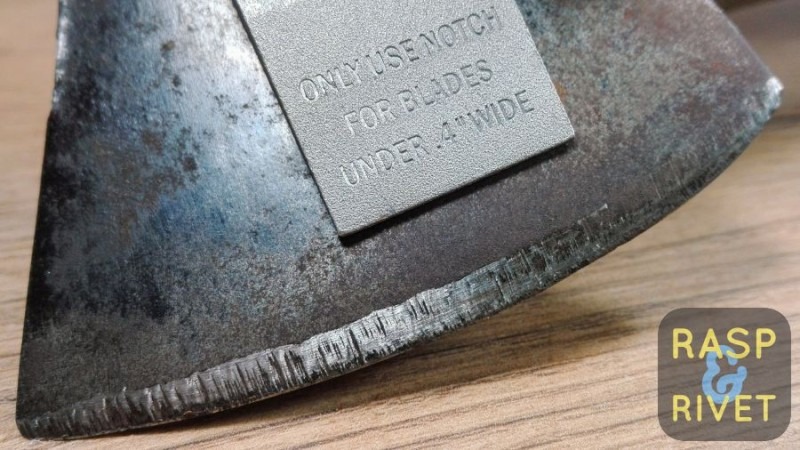 the other side of the axe head before sharpening
the other side of the axe head before sharpening one side of the axe head after sharpening
one side of the axe head after sharpening the traditional arm hair cutting test proves that the lansky did a fine job of sharpening this axe
the traditional arm hair cutting test proves that the lansky did a fine job of sharpening this axe an old raco chisel before sharpening with the lansky
an old raco chisel before sharpening with the lansky the chisel is in a terrible condition
the chisel is in a terrible condition the chisel has never been sharpened
the chisel has never been sharpened the chisel, clamped to half of the lansky clamp with a vice grip
the chisel, clamped to half of the lansky clamp with a vice grip the nose after sharpening it with the lansky
the nose after sharpening it with the lansky i honed the bottom of the raco chisel too
i honed the bottom of the raco chisel too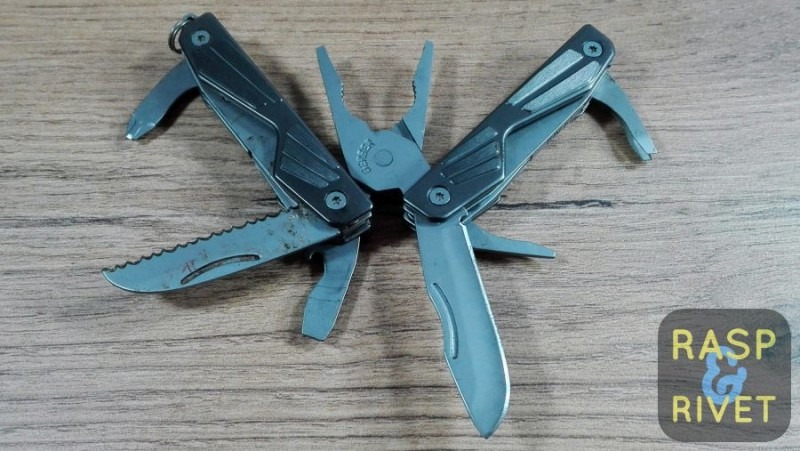 the gerber mini multi tool, the blade of which i sharpened with the lansky
the gerber mini multi tool, the blade of which i sharpened with the lansky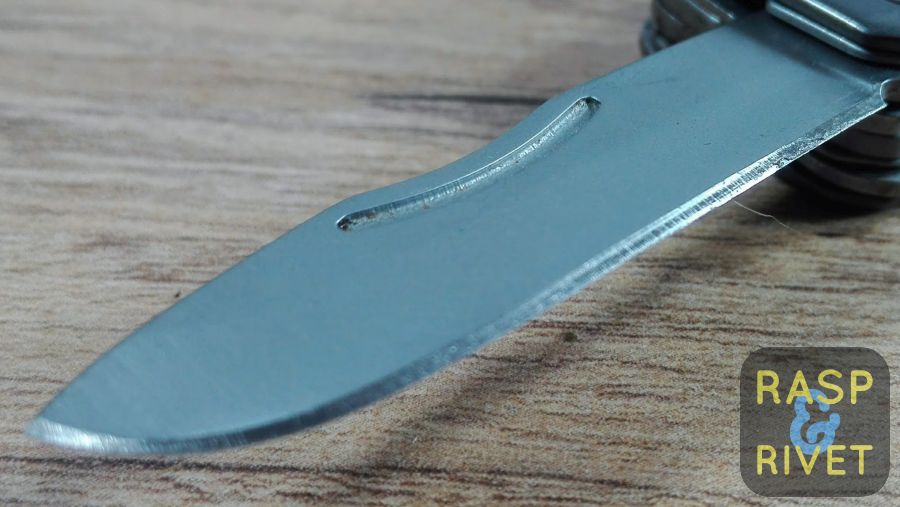 one side of the gerber mini multi tool's blade before sharpening with the lansky
one side of the gerber mini multi tool's blade before sharpening with the lansky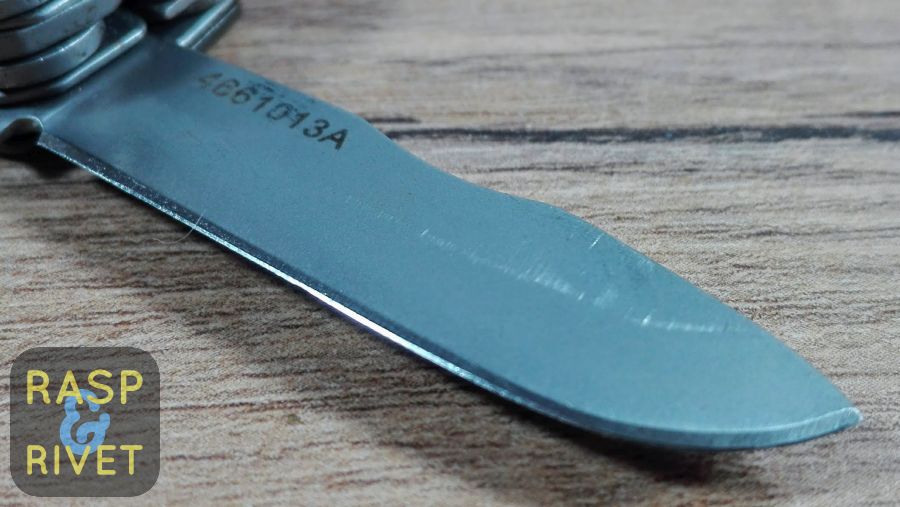 the other side of the gerber mini multi tool's blade before sharpening with the lansky
the other side of the gerber mini multi tool's blade before sharpening with the lansky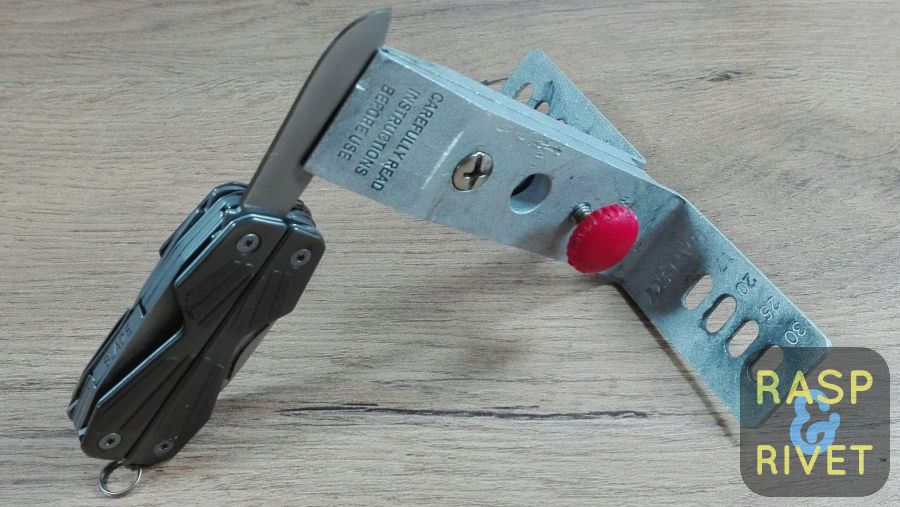 the gerber mini multi tool clamped in the lansky
the gerber mini multi tool clamped in the lansky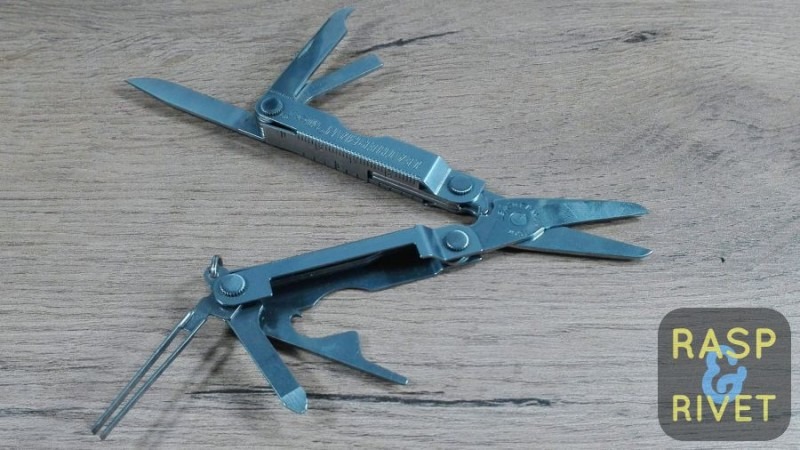 the leatherman micra, the blade of which i sharpened with the lansky
the leatherman micra, the blade of which i sharpened with the lansky one side of the leatherman micra's blade before sharpening with the lansky
one side of the leatherman micra's blade before sharpening with the lansky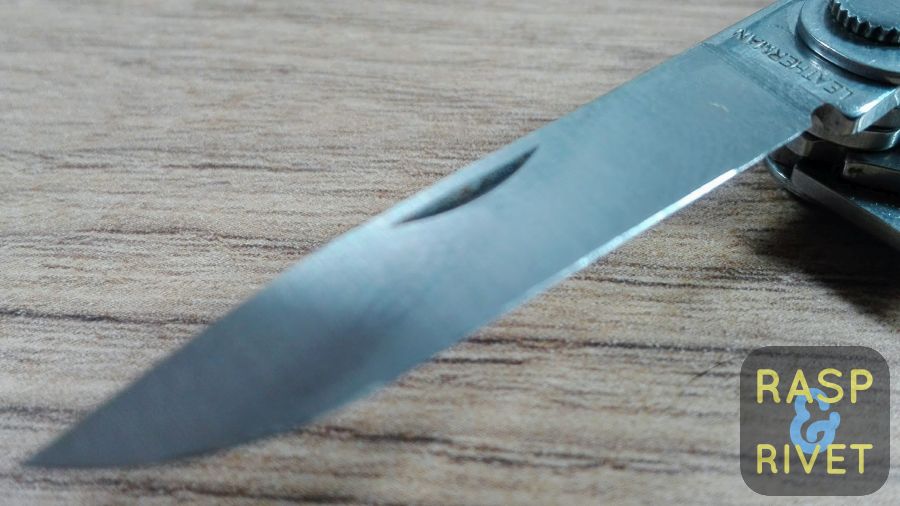 the other side of the leatherman micra's blade before sharpening with the lansky
the other side of the leatherman micra's blade before sharpening with the lansky the leatherman micra clamped in the lansky
the leatherman micra clamped in the lansky one side of the leatherman micra's blade after sharpening with the lansky
one side of the leatherman micra's blade after sharpening with the lansky the other side of the leatherman micra's blade after sharpening with the lansky
the other side of the leatherman micra's blade after sharpening with the lanskyI bought the Lansky Deluxe 5-stone knife sharpening kit. The best thing about it? I Hear these words when I enter the kitchen: “Babes, these new* knives cut so much better than the old ones.”
The knives aren’t new, but they cut like new—even better—after a session with the Lansky.
*My wife knows they’re not new, but that’s her way of speaking.
I didn’t use the Lansky; I abused it.
I spent more than 10 hours sharpening steak knives, chef’s knives, an ax, a pair of scissors, mini multi-tools, and a woodworking chisel. In this post, I show you how to use the Lansky and how a sharp blade makes a world of difference.
If you’re not convinced by the end of this post that a Lansky is a great tool, I’ll abstain from eating for 60 minutes.
I’m an Average Joe. I don’t have a love affair with knives. They’re tools. As long as the knife in my hand cuts well, I couldn’t care less about what type of knife it is, or the brand.
But a blunt knife is a pain in the nether regions. It drags out the task and wastes your energy.
And don’t think a new knife comes with a sharp edge. You’ll not find a new mass-produced knife with a razor’s edge. Some people don’t know this. They buy a knife and start hacking and chopping and slicing away. They think that the blade is sharp because it’s new.
Not necessarily.
Most knives are made on production lines. Manufacturers aren’t concerned with giving you a sharp tool. They’ll give you a working product, but you must make it better.
There’s a remarkable difference between a dull blade and a sharp blade.
A knife with a dull edge multiplies your pain. It drains your energy and wastes time. A sharp blade makes your cutting task painless and quick. You’ll experience it firsthand when you start sharpening your knives.
That’s where the Lansky comes in.
Benefits
The Lansky is amazing for the following reasons.
Saves time
It’s a truism that a sharp knife works faster than a dull knife. I don’t need to prove this. It’s a vanilla fact.
How much time do you waste on cutting with a sub-par cutting edge?
Run a test using a blunt knife and a sharpened knife. Cut various items with both and note the time difference. You’d be surprised at how much time a dull blade costs you.
Saves energy
My wife’s the chef in our home. She’s good at cooking. Her food’s my favorite.
We’re meat and veggie eaters. We eat plenty of pumpkins. They’re difficult to cut. My wife often calls me into the kitchen for cutting duty. It’s an exhausting task for her, even with a sharp knife. Throw in a dull blade and it becomes a drag. A sharp blade makes the task easier.
Handles a beating
I didn’t expect the honing stones to last long. As mentioned earlier, I didn’t use the Lansky, I abused it. I read the manual, snorted at their directions, and did my own thing.
The Lansky took it.
After more than ten hours of assault, the honing stones are fine. They’re like Rocky Balboa. A few scratches here and there, but ready for another round.
Dislikes
The Lansky isn’t perfect. Here are my main issues with it.
Screws don’t tighten well
The Lansky doesn’t grip a blade well IF you don’t tighten the main screw with a pair of pliers. I didn’t use a pair of pliers the first time I sharpened a knife, so the knife shifted while I worked on it. This caused me to lose the sharpening angle.
After this experience, I started tightening the locking screw with pliers. It works fine, despite my initial doubts.
I would have preferred the Lansky with hex button-head cap screws, though.
A file extension would work well
While sharpening the ax, I couldn’t help but wonder why Lansky doesn’t make a file extension for working down rough edges. Lansky makes a heavy-duty tool sharpener, but it doesn’t work in the same way their honing stones work. They could design a tool sharpener with a guide rod extension.
It won’t work well on all metals. A file has no effect on hard metal. But there are cases where a file would work well.
Price
You can buy the Lansky online for ~$32. That excludes shipping costs.
Compare this to knife sharpening services in the USA. You’ll pay from $1.75 to $3 per inch. Add shipping—$5 per order—and your bill for sending in knives soon surpass Lansky’s price.
Let’s do some calculations.
I sharpened 16 blades with a combined length of 1,784mm (70.24 inches).
Let’s cut the sharpening price to $1.50 per inch AND exclude shipping costs.
70.24 inches x $1.50 per inch = $105.36.
It would cost you $105 to have your knives sharpened by someone else. Remember, that doesn’t include shipping.
The Lansky lets you do the job at less than a third of the price.
Yes, it takes time to sharpen blades, but it saves you plenty of money.
Besides, what if you want to try a different angle on one of your knives? With Lansky, you can experiment. If you don’t like your new angle, hone it back to the old one.
Warranty
I emailed Lansky for warranty info. They responded with a PDF document outlining their Limited Lifetime Product Warranty.
Here it is, verbatim:
Warranty: Lansky warranties this item to be free from defects in material and workmanship for the life of this tool. Damages caused by alteration, misuse, or abuse are not covered by this guarantee. Lansky disclaims any responsibility for incidental or consequential damages.
European Union Warranty: Lansky warranties this item to be free from defects in material and workmanship for the life of this tool. Damages caused by alteration, misuse or abuse are not covered by this guarantee.
Lansky disclaims any responsibility for incidental or consequential damages. This guarantee is in addition to and does not affect your statutory rights with respect to faulty goods.
If your product has a manufacturer’s defect which is covered by this guarantee, we will repair or replace it (at our option). Return the item directly to us at:
Lansky Warranty Center
10 Aqua Lane, Tonawanda, NY 14150 U.S.A
Here is a link to download a PDF version of Lansky’s warranty.
In the box
The Lansky Deluxe 5-stone box contains the following items:
- Plastic storage case
- Knife clamp with angle selector
- Five guide rods
- Honing oil
- Five sharpening stones:
- Black, 70 grit, extra coarse
- Red, 120 grit, coarse
- Green, 280 grit, medium
- Blue, 600 grit, fine
- Yellow, 1000 grit, ultra fine
- Extra honing stone wingnut
- Extra front screw for clamp
Note: I received the 35-year anniversary edition of Lansky. There are slight cosmetic differences, but what I review and what you buy are the same thing.
Only standard honing stones
The Deluxe 5-stone kit doesn’t come with half-round or triangle honing stones, used for sharpening serrated blades.
It comes with five flat-honing stones. You can only use it for sharpening smooth-edged blades.
How to use
It’s easy to use the Lansky. Follow along, but…
Before you start
Before using the Lansky, know the following:
- The Lansky doesn’t do well on the long blades. There’s a big difference in the sharpening angle from one end of the edge to the other.
- This doesn’t bother me, but it’s something to keep in mind.
- Oil the honing stones before and during use.
- The Lansky Deluxe kit comes with honing oil. If you run out, use mineral oil (medicinal liquid paraffin).
- The sharpening angle is a guideline. It’s not perfect. The blade’s width and length determine the actual angle.
- When you sharpen a knife for the first time, mark the Lansky’s position on the knife, while it’s clamped. The next time you sharpen the knife, you won’t have to worry about having to create a new edge from scratch.
- Tighten the clamp screw with a pair of pliers. Your fingers won’t do a good enough job.
- Tighten the honing stone rod extensions with a pair of pliers, or else they keep coming loose.
- It’s a dirty job. Have something handy to clean your hands with.
- Wear gloves if you don’t like cutting your hands.
Follow these steps
Follow these steps to sharpen a knife with the Lansky Deluxe…
- Attach the guide rods to the honing stones.
- Use a pair of pliers. If the guide rod isn’t tight, it moves around, causing mild frustration.
- Make sure the knife clamp bolts are loose.
- Slide the knife into the knife clamp slot.
- If the blade’s wide, don’t use the slot. Seat the knife against the Phillips screw.
- Tighten the Phillips screw.
- Tighten the red screw.
- Use a pair of pliers to tighten it.
- Drip oil onto the honing stones. Rub it into the stones with your finger.
- The oil keeps the stones lubricated AND keeps them from clogging.
- Start with the 70-grit stone (if the cutting edge is in a bad condition), working your way up to the 1000-grit.
- The 70 grit is the roughest stone. If the blade isn’t too bad, you can start with a smoother stone.
- Slide the guide rod into one of Lansky’s angle slots.
- Lay the honing stone on the blade’s edge.
- Applying pressure, push the stone up and sideways, toward the clamp’s center. Cover one to two inches.
- Once the edge is sharp, remove the honing stone and guide rod.
- Flip the whole thing over.
- On the other side, slide the guide rod into one of Lansky’s angle slots.
- Lay the honing stone on the blade’s edge.
- Applying pressure, push the stone up and sideways, toward the clamp’s center. Cover one to two inches.
- When you’re finished with the last honing stone, loosen the screws and remove the knife.
- Wash the knife and start cutting.
Sharpening angles
The Lansky has four sharpening angles:
- 17 degrees
- Recommended for razor blades, fillet knives, and similar tools.
- 20 degrees
- Recommended for kitchen cutlery and slicing knives.
- 25 degrees
- Recommended for hunting and outdoor knives.
- 30 degrees
- Recommended for cardboard, wire and carpet cutting knives, and other heavy-duty blades.
Inaccurate sharpening angles
Lansky’s angles aren’t accurate. Two factors determine the sharpening angle. These are:
- The blade’s width.
- The blade’s placement inside the knife clamp.
I’m no mathematician, but let me explain the hypotenuse concept as best I can.
The Lansky, with the honing stone and guide rod in place and resting on the knife, creates a triangle. They call one side of that triangle, the one represented by the honing stone, the hypotenuse.
The hypotenuse is the longest side of a right-angled triangle, opposite the right angle.
On the Lansky, the hypotenuse is the length from the knife’s edge to the edge of the hole through which you stick the honing stone extension.
The further you move the edge, or the wider the blade, the longer the hypotenuse becomes. This changes the sharpening angle.
To further complicate things, the Lansky struggles to accommodate a long blade. There’s a big difference between the honing angle closest to the knife clamp, and the honing angle at the point farthest from the clamp. This shows best on longer blades.
But you won’t mind these shortcomings once you see the difference a sharp blade makes.
True sharpening angles
To determine the Lansky’s true sharpening angles, I measured two knives while they were clamped in the Lansky. One’s a steak knife, the other a chef’s knife.
Note: These calculations aren’t rock solid. I don’t have digital measuring equipment. I own a standard vernier caliper and ruler. The purpose of this exercise is to show you the difference between angles a small distance makes, not to give you exact scientific data.
Here are the specs…
| Chef’s knife (metric) | Chef’s knife (Imperial) | Steak knife (metric) | Steak knife (Imperial) | |
|---|---|---|---|---|
| Shortest right angle length | 130.8mm | 5.15 inches | 110mm | 4,33 inches |
| Longest right angle length | 188mm | 7.40 inches | 136.4mm | 5.37 inches |
| Hypotenuse – 30 degrees – longest angle | 194mm | 7.64 inches | 144mm | 5.67 inches |
| Hypotenuse – 30 degrees – shortest angle | 138mm | 5.43 inches | 118.8mm | 4.67 inches |
| Hypotenuse – 25 degrees – longest angle | 193mm | 7.60 inches | 141.5mm | 5.57 inches |
| Hypotenuse – 25 degrees – shortest angle | 135.8mm | 5.35 inches | 115.8mm | 4.56 inches |
| Hypotenuse – 20 degrees – longest angle | 191mm | 7.52 inches | 140mm | 5.51 inches |
| Hypotenuse – 20 degrees – shortest angle | 134mm | 5.28 inches | 114mm | 4.49 inches |
| Hypotenuse – 17 degrees – longest angle | 190mm | 7.48 inches | 139mm | 5.47 inches |
| Hypotenuse – 17 degrees – shortest angle | 132.5mm | 5,22 inches | 112.5mm | 4.43 inches |
| Cutting edge length | 188mm | 7.40 inches | 115mm | 4.53 inches |
| Blade’s width (at widest point) | 41.4mm | 1.63 inches | 21mm | 0.83 inches |
Note: Do not clamp your knives as I did in the pictures below. I did it to make a point, not for sharpening.
Here are the sharpening angles for these knives, based on the specs above.
| Lansky angle slot | Chef’s knife sharpening angle | Steak knife sharpening angle |
|---|---|---|
| 30 degrees – longest distance | 28.57 degrees | 37.4 degrees |
| 30 degrees – shortest distance | 37.18 degrees | 44.38 degrees |
| 25 degrees – longest distance | 26.14 degrees | 30.86 degrees |
| 25 degrees – shortest distance | 31.19 degrees | 36.42 degrees |
| 20 degrees – longest distance | 20.34 degrees | 26.04 degrees |
| 20 degrees – shortest distance | 25.09 degrees | 30.45 degrees |
| 17 degrees – longest distance | 16.64 degrees | 22.2 degrees |
| 17 degrees – shortest distance | 18.38 degrees | 24.2 degrees |
Sharpening at the right angle depends on more than the markings on the Lansky.
Yet, this does not make the Lansky a bad tool. It’s close enough. The knives I sharpened at these angles work well.
Sharpening grit
The Lansky Deluxe comes with five stones:
- 70 grit
- Extra coarse
- Black handle
- 120 grit
- Coarse
- Red handle
- 280 grit
- Medium
- Green handle
- 600 grit
- Fine
- Blue handle
- 1000 grit
- Ultra fine
- Yellow handle
Use the coarsest stone (70 grit) for rough edges. Use the finest stone (1000 grit) for finishing an edge.
Sharpening
For this post, I sharpened 16 blades. These are my findings.
Steak knife
We own a set of cheap Shogun steak knives. The Lansky is perfect for this type of blade.
I started with the 70 grit, although I could have started with a finer grit. These knives aren’t too dull.
I opted for Lansky’s 20-degree angle.
How long it took
It took 34 minutes to sharpen the steak knife. Here’s the breakdown:
- 70 grit – 15 minutes
- 120 grit – 6 minutes
- 280 grit – 3 minutes
- 600 grit – 5 minutes
- 1000 grit – 5 minutes
Chef’s knife
I found a monstrous chef’s knife in the kitchen, which took longer to sharpen than the ax head. This was surprising.
I started with the 70 grit and used Lansky’s 20-degree angle.
How long it took
It took 85 minutes to sharpen the chef’s knife. Here’s the breakdown:
- 70 grit – 76 minutes
- 120 grit – 3 minutes
- 280 grit – 2 minutes
- 600 grit – 2 minutes
- 1000 grit – 2 minutes
Meat cleaver
This was an easy operation. The Lansky did a fine job of sharpening the cleaver’s edge.
The meat cleaver’s blade doesn’t have much curve. The straighter the edge, the better the Lansky works.
How long it took
It took 26 minutes to sharpen the meat cleaver. Here’s the breakdown:
- 70 grit – 18 minutes
- 120 grit – 2 minutes
- 280 grit – 2 minutes
- 600 grit – 2 minutes
- 1000 grit – 2 minutes
Pair of scissors
I had to stretch my imagination for this one. The Lansky is not made for sharpening scissors. I managed to do it only by using a vice grip to secure the scissors to the Lansky.
The scissor’s blade protruded far beyond the Lansky clamp. I had to hold a finger to the blade while honing, to cut vibration.
How long it took
It took about ten minutes.
Ax head
Of course, you can sharpen an ax head with the Lansky 5-stone Deluxe. It takes imagination, but it’s doable.
You’ll need something to secure the Lansky’s two parts to the ax head with. I used a vice grip, but cable ties should work too.
The ax’s cutting edge had an original angle in the 20-degree range. It was too sharp. I changed it to 25 degrees. You could increase it to 30 degrees and give it a compound bevel.
I did not prep the ax with a grinder or sanding belt. I took to it with the 70 grit honing stone.
How long it took
It took 72 minutes to sharpen the ax head. The edge was in a bad state, so I made the 70 grit stone sweat. Here’s the breakdown:
- 70 grit – 55 minutes
- 120 grit – 6 minutes
- 280 grit – 5 minutes
- 600 grit – 2 minutes
- 1000 grit – 4 minutes
Serrated blade
The Lansky Deluxe 5-stone doesn’t come with a honing stone for serrated blades. If you want to sharpen serrated blades, take a look at these Lansky sharpening stones…
Medium hone
A medium grit triangle hone for serrated blades.
Fine hone
A fine-grit triangle hone for serrated blades.
Chisel
Like with the ax, it takes imagination to sharpen a chisel.
I secured the Lansky clamp to a 0,787in (20mm) chisel with a vice grip and sharpened it to 30 degrees. I opted for a single bevel, but you could give it a double bevel, with 25- and 30-degree angles.
I did not prepare the chisel beforehand. I only used the Lansky.
How long it took
It took 355 minutes (yes, 5.9 hours) to sharpen the chisel. The edge was in a bad state, so the 70 grit stone worked overtime.
This was a murderous undertaking. It took Shawshank Redemption and some Community episodes to get me through the tedium.
I would not recommend using the Lansky for heavy-duty chisel sharpening. Start with a bench grinder.
Here’s the breakdown:
- 70 grit – 225 minutes
- 120 grit – 88 minutes
- 280 grit – 32 minutes
- 600 grit – 5 minutes
- 1000 grit – 5 minutes
Multi-tool
I own a Leatherman Micra and Gerber mini multi-tool. I sharpened the blades of these tools.
Don’t buy a Gerber mini multi-tool, by the way. The built-in pair of pliers is weak.
How long it took
It took ten to 15 minutes to sharpen each of these blades. It was a breeze since the blades are small.
Apologies for the blurry pics. I was impatient. Wanted to get the article finished and delivered to your door.
Cutting tests
I made a video showing the difference a sharp blade makes in cutting various items.
I used only two steak knives and two chef’s knives. One of each was blunt. I sharpened the other two with the Lansky.
My sincere apologies to videographers everywhere, for the terrible video. I hope to improve upon my video making skills.
How long does a blade stay sharp?
I can’t answer this. A blade’s toughness is based on the type of material it’s made from and the type of treatment it received.
If your knife is made from the wrong metal and/or they messed up the heat treatment, it won’t stay sharp. You’ll spend more time on sharpening than you should.
Blade care tips
Tips to keep your blade in good condition:
- Hang your kitchen knives. Don’t smash them into a drawer where the blades come into contact with each other.
- Sheath your knife or ax.
- Keep your blades lubricated. Not kitchen knives. You don’t want your meat to taste like oil.
- Use mineral oil for kitchen knives if you must lubricate them.
- Don’t wash your knives in a dishwasher. If you do, make sure it doesn’t make contact with anything that could hurt the blades.
Is the honing oil food safe?
I asked Lansky about this and they sent me a safety data sheet. Click here to download a PDF version of it.
According to the safety data sheet, the honing oil is a “Highly Refined Petroleum Base Oil”.
The SDS contains the following general precautionary statements:
- Keep out of reach of children.
- Read the label before use.
- Wash skin thoroughly after handling.
- IF SWALLOWED: Rinse mouth. Do NOT induce vomiting.
- IF IN EYES: Rinse cautiously with water for several minutes. Remove contact lenses, if present and easy to do. Continue rinsing.
- Get medical advice/attention if you feel unwell.
Come to think of it, I once swallowed a mouthful of hydraulic oil. Aside from the disgusting taste, it caused me no harm. But I’m not condoning your drinking of oil. Don’t do it.
The best type of oil
If you want food-safe oil, get mineral oil. You can buy pure food-grade mineral oil in large quantities. It was not expensive.
Visit Amazon and search for Sanco mineral oil.
Alternative sharpener?
My go-to knife sharpener is the Warthog V-Sharp Classic 2. It can’t sharpen serrated blades, but it’s easier to use and quicker on smooth edges, than the Lansky.
Final thoughts
I love the Lansky. It gives you a well-sharpened edge at a great price. If you compare the cost of a Lansky to the cost of sending your blades away, the Lansky wins by a landslide.
Is a sharp edge important for cutting?
You could plod along with a dull knife, but once you sharpen your blade with a Lansky, a blunt won’t do.
The Lansky isn’t perfect, but the few niggles are negligible, especially considering the price.
Sources:
